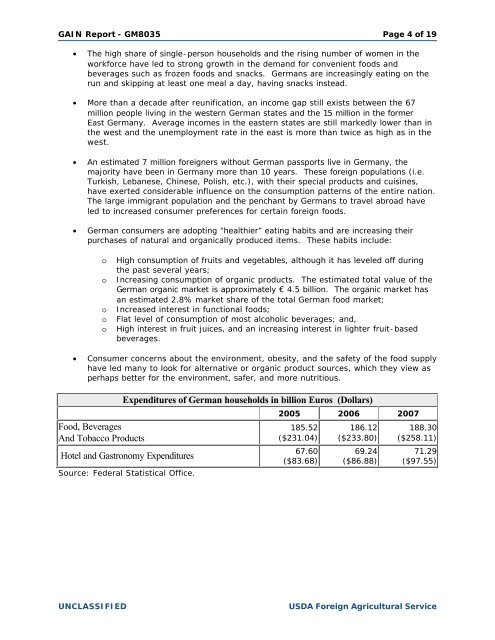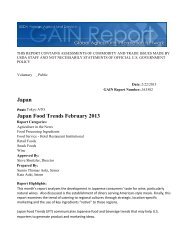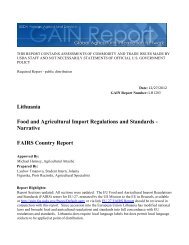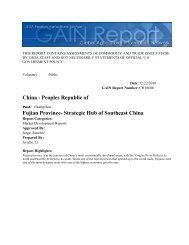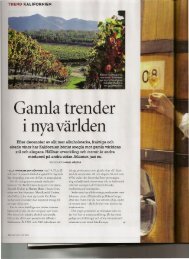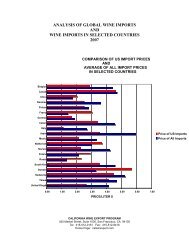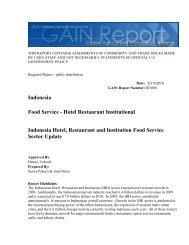Germany HRI Food Service Sector Food Service Sector in Germany ...
Germany HRI Food Service Sector Food Service Sector in Germany ...
Germany HRI Food Service Sector Food Service Sector in Germany ...
You also want an ePaper? Increase the reach of your titles
YUMPU automatically turns print PDFs into web optimized ePapers that Google loves.
GAIN Report - GM8035 Page 4 of 19<br />
• The high share of s<strong>in</strong>gle-person households and the ris<strong>in</strong>g number of women <strong>in</strong> the<br />
workforce have led to strong growth <strong>in</strong> the demand for convenient foods and<br />
beverages such as frozen foods and snacks. Germans are <strong>in</strong>creas<strong>in</strong>gly eat<strong>in</strong>g on the<br />
run and skipp<strong>in</strong>g at least one meal a day, hav<strong>in</strong>g snacks <strong>in</strong>stead.<br />
• More than a decade after reunification, an <strong>in</strong>come gap still exists between the 67<br />
million people liv<strong>in</strong>g <strong>in</strong> the western German states and the 15 million <strong>in</strong> the former<br />
East <strong>Germany</strong>. Average <strong>in</strong>comes <strong>in</strong> the eastern states are still markedly lower than <strong>in</strong><br />
the west and the unemployment rate <strong>in</strong> the east is more than twice as high as <strong>in</strong> the<br />
west.<br />
• An estimated 7 million foreigners without German passports live <strong>in</strong> <strong>Germany</strong>, the<br />
majority have been <strong>in</strong> <strong>Germany</strong> more than 10 years. These foreign populations (i.e.<br />
Turkish, Lebanese, Ch<strong>in</strong>ese, Polish, etc.), with their special products and cuis<strong>in</strong>es,<br />
have exerted considerable <strong>in</strong>fluence on the consumption patterns of the entire nation.<br />
The large immigrant population and the penchant by Germans to travel abroad have<br />
led to <strong>in</strong>creased consumer preferences for certa<strong>in</strong> foreign foods.<br />
• German consumers are adopt<strong>in</strong>g “healthier” eat<strong>in</strong>g habits and are <strong>in</strong>creas<strong>in</strong>g their<br />
purchases of natural and organically produced items. These habits <strong>in</strong>clude:<br />
o High consumption of fruits and vegetables, although it has leveled off dur<strong>in</strong>g<br />
the past several years;<br />
o Increas<strong>in</strong>g consumption of organic products. The estimated total value of the<br />
German organic market is approximately € 4.5 billion. The organic market has<br />
an estimated 2.8% market share of the total German food market;<br />
o Increased <strong>in</strong>terest <strong>in</strong> functional foods;<br />
o Flat level of consumption of most alcoholic beverages; and,<br />
o High <strong>in</strong>terest <strong>in</strong> fruit juices, and an <strong>in</strong>creas<strong>in</strong>g <strong>in</strong>terest <strong>in</strong> lighter fruit-based<br />
beverages.<br />
• Consumer concerns about the environment, obesity, and the safety of the food supply<br />
have led many to look for alternative or organic product sources, which they view as<br />
perhaps better for the environment, safer, and more nutritious.<br />
<strong>Food</strong>, Beverages<br />
And Tobacco Products<br />
Expenditures of German households <strong>in</strong> billion Euros (Dollars)<br />
Hotel and Gastronomy Expenditures<br />
Source: Federal Statistical Office.<br />
2005 2006 2007<br />
185.52<br />
($231.04)<br />
67.60<br />
($83.68)<br />
186.12<br />
($233.80)<br />
69.24<br />
($86.88)<br />
188.30<br />
($258.11)<br />
71.29<br />
($97.55)<br />
UNCLASSIFIED USDA Foreign Agricultural <strong>Service</strong>


